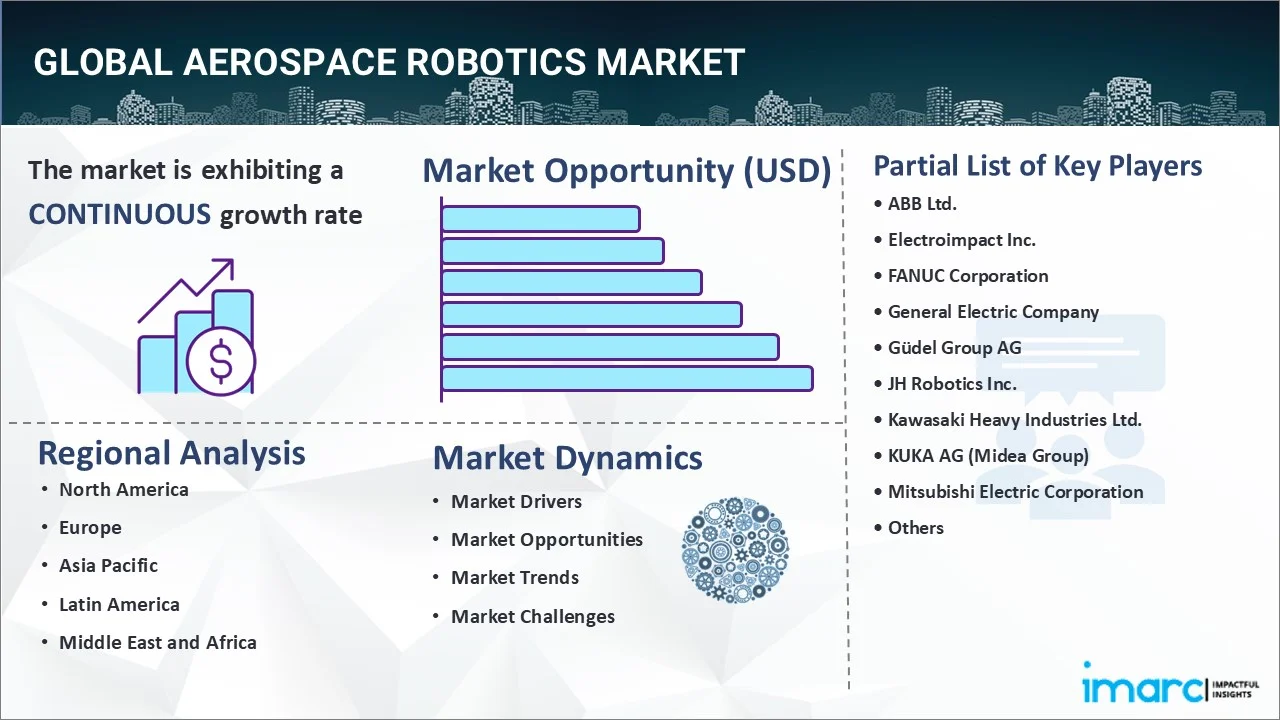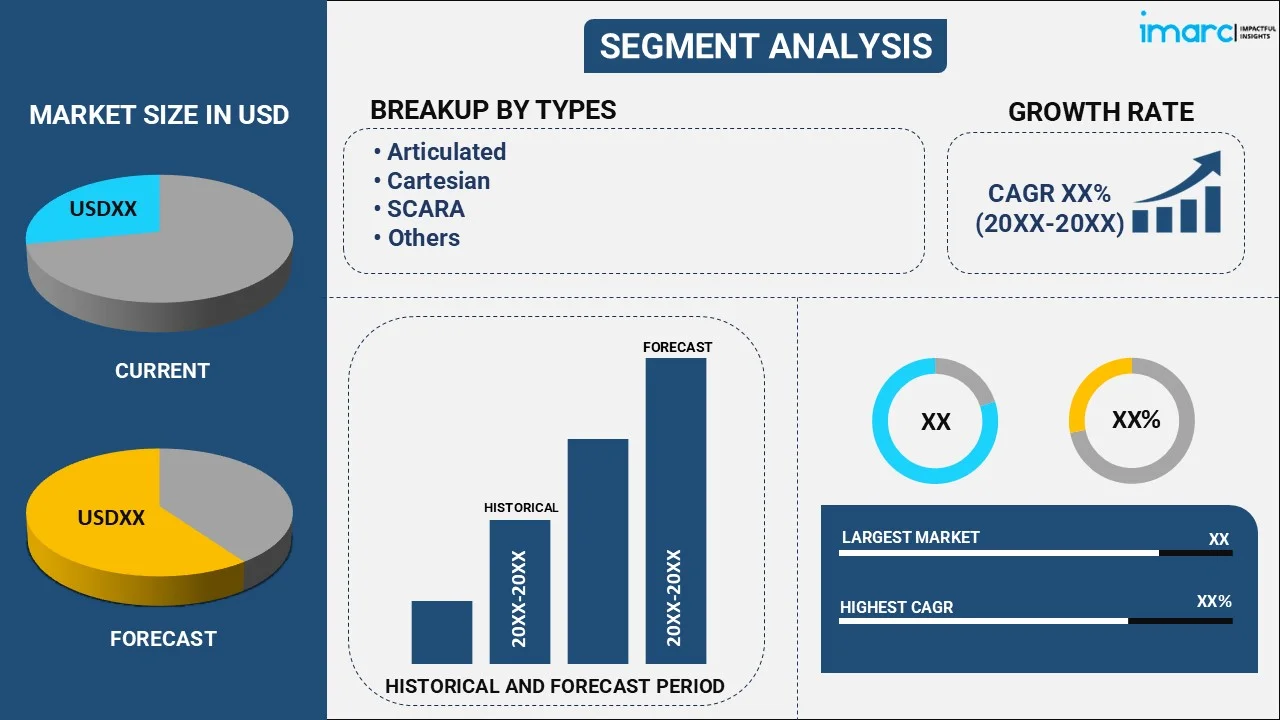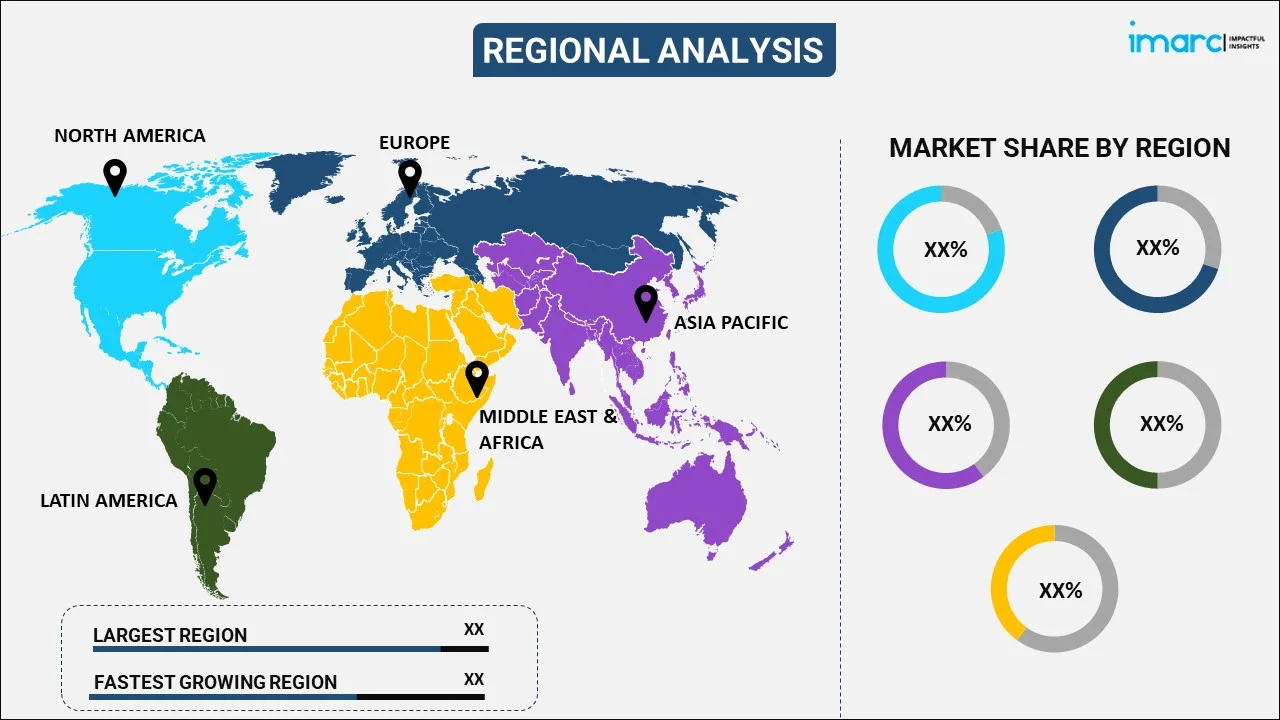
Aerospace Robotics Market Report by Type (Articulated, Cartesian, SCARA, Parallel, and Others), Component (Controller, Arm Processor, End Effector, Camera and Sensors, and Others), Technology (Traditional, Collaborative), Payload (Up to 16.00 KG, 16.01–60.00 KG, 60.01–225.00 KG, More than 225.00 KG), Application (Drilling, Welding, Painting, Inspection, and Others), and Region 2025-2033
Market Overview:
The global aerospace robotics market size reached USD 3.8 Billion in 2024. Looking forward, IMARC Group expects the market to reach USD 8.4 Billion by 2033, exhibiting a growth rate (CAGR) of 8.79% during 2025-2033.
|
Report Attribute
|
Key Statistics
|
|---|---|
|
Base Year
|
2024
|
|
Forecast Years
|
2025-2033
|
|
Historical Years
|
2019-2024
|
|
Market Size in 2024
|
USD 3.8 Billion |
|
Market Forecast in 2033
|
USD 8.4 Billion |
| Market Growth Rate 2025-2033 | 8.79% |
Aerospace robotics refers to the robots used for the assembly and maintenance of aircraft, satellites and space shuttles. They are commonly used for executing sensitive tasks, such as material handling, cutting, riveting, bolting, welding and fabrication of exterior and interior components of the aircraft. They are also utilized for detecting minute variations in the thickness, patency and integrity of aircraft skins, airfoils and paint coatings. Aerospace robotics usually operate through articulated, cartesian, cylindrical, spherical, parallel and selective compliance articulated robot arm (SCARA) technologies. In comparison to the traditionally used manual systems, aerospace robotics solutions can perform repeated tasks with enhanced accuracy and offer consistent and speedy results. Space robotics also find extensive application for autonomously operating on new planetary surfaces.

Aerospace Robotics Market Trends:
Significant growth in the aerospace and aviation industries across the globe is one of the key factors creating a positive outlook for the market. Moreover, the increasing requirement for automating various labor-intensive inspection, fiber placement, sealing and dispensing processes is providing a thrust to the market growth. In line with this, the widespread production of narrow-body aircraft with lightweight and small-sized components is providing a thrust to the growth of the market. Various technological advancements, such as the integration of robotics with 3D visualization, Internet of Things (IoT), artificial intelligence (AI) and cloud computing solutions, are acting as other growth-inducing factors. These technologies aid in improving human-robot collaboration and minimizing the turnaround time for the manufacturing processes. Other factors, including extensive research and development (R&D) activities, along with significant improvements in the cyber-physical system (CPS) with automated decision-making functionalities, are anticipated to drive the market toward growth.
Key Market Segmentation:
IMARC Group provides an analysis of the key trends in each sub-segment of the global aerospace robotics market report, along with forecasts at the global, regional and country level from 2025-2033. Our report has categorized the market based on type, component, technology, payload and application.
Breakup by Type:

- Articulated
- Cartesian
- SCARA
- Parallel
- Others
Breakup by Component:
- Controller
- Arm Processor
- End Effector
- Camera and Sensors
- Others
Breakup by Technology:
- Traditional
- Collaborative
Breakup by Payload:
- Up to 16.00 KG
- 16.01–60.00 KG
- 60.01–225.00 KG
- More than 225.00 KG
Breakup by Application:
- Drilling
- Welding
- Painting
- Inspection
- Others
Breakup by Region:

- North America
- United States
- Canada
- Asia-Pacific
- China
- Japan
- India
- South Korea
- Australia
- Indonesia
- Others
- Europe
- Germany
- France
- United Kingdom
- Italy
- Spain
- Russia
- Others
- Latin America
- Brazil
- Mexico
- Others
- Middle East and Africa
Competitive Landscape:
The competitive landscape of the industry has also been examined along with the profiles of the key players being ABB Ltd., Electroimpact Inc., FANUC Corporation, General Electric Company, Güdel Group AG, JH Robotics Inc., Kawasaki Heavy Industries Ltd., KUKA AG (Midea Group), Mitsubishi Electric Corporation, Teradyne Inc. and Yaskawa Electric Corporation.
Report Scope:
| Report Features | Details |
|---|---|
| Base Year of the Analysis | 2024 |
| Historical Period | 2019-2024 |
| Forecast Period | 2025-2033 |
| Units | Billion USD |
| Segment Coverage | Type, Component, Technology, Payload, Application, Region |
| Region Covered | Asia Pacific, Europe, North America, Latin America, Middle East and Africa |
| Countries Covered | United States, Canada, Germany, France, United Kingdom, Italy, Spain, Russia, China, Japan, India, South Korea, Australia, Indonesia, Brazil, Mexico |
| Companies Covered | ABB Ltd., Electroimpact Inc., FANUC Corporation, General Electric Company, Güdel Group AG, JH Robotics Inc., Kawasaki Heavy Industries Ltd., KUKA AG (Midea Group), Mitsubishi Electric Corporation, Teradyne Inc. and Yaskawa Electric Corporation |
| Customization Scope | 10% Free Customization |
| Post-Sale Analyst Support | 10-12 Weeks |
| Delivery Format | PDF and Excel through Email (We can also provide the editable version of the report in PPT/Word format on special request) |
Key Questions Answered in This Report
The global aerospace robotics market was valued at USD 3.8 Billion in 2024.
We expect the global aerospace robotics market to exhibit a CAGR of 8.79% during 2025-2033.
The sudden outbreak of the COVID-19 pandemic had led to the implementation of stringent lockdown regulations across several nations resulting in the decline of numerous aviation activities, thereby negatively impacting the global market for aerospace robotics.
The rising integration of aerospace robotics with 3D visualization, IoT, AI, and cloud computing solutions for improving human-robot collaboration and minimizing the turnaround time for the manufacturing processes, is primarily driving the global aerospace robotics market.
Based on the type, the global aerospace robotics market has been divided into articulated, cartesian, SCARA, parallel, and others. Among these, articulated currently exhibits a clear dominance in the market.
Based on the component, the global aerospace robotics market can be categorized into controller, arm processor, end effector, camera and sensors, and others. Currently, controller accounts for the majority of the total market share.
Based on the technology, the global aerospace robotics market has been segregated into traditional and collaborative, where traditional currently holds the largest market share.
Based on the application, the global aerospace robotics market can be bifurcated into drilling, welding, painting, inspection, and others. Currently, drilling exhibits a clear dominance in the market.
On a regional level, the market has been classified into North America, Asia-Pacific, Europe, Latin America, and Middle East and Africa, where North America currently dominates the global market.
Some of the major players in the global aerospace robotics market include ABB Ltd., Electroimpact Inc., FANUC Corporation, General Electric Company, Güdel Group AG, JH Robotics Inc., Kawasaki Heavy Industries Ltd., KUKA AG (Midea Group), Mitsubishi Electric Corporation, Teradyne Inc., and Yaskawa Electric Corporation.
Need more help?
- Speak to our experienced analysts for insights on the current market scenarios.
- Include additional segments and countries to customize the report as per your requirement.
- Gain an unparalleled competitive advantage in your domain by understanding how to utilize the report and positively impacting your operations and revenue.
- For further assistance, please connect with our analysts.
 Inquire Before Buying
Inquire Before Buying
 Speak to an Analyst
Speak to an Analyst
 Request Brochure
Request Brochure
 Request Customization
Request Customization




.webp)




.webp)












